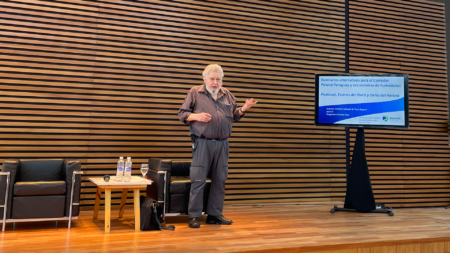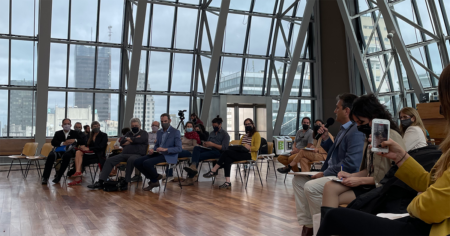
Possible futures for the Paraná-Paraguay Corridor wetlands
-
Corredor Azul
Please note, the original article is published in Spanish and can be found here.
Our latest publication, “Escenarios alternativos para el futuro del Corredor Paraná-Paraguay y sus sistemas de humedales: Pantanal, Esteros del Iberá y Delta del Paraná”, was launched at the Centro Cultural Kirchner in Buenos Aires last month. This work, written by the renowned biologist Gilberto Gallopín, is based on studies by 40 researchers from Argentina and Brazil, and it considers complex future scenarios for the Paraná-Paraguay wetlands. Protecting and preserving these ecosystems is vital to mitigate the effects of climate change.
On 16 November, 2021, we launched our latest release, Escenarios alternativos para el futuro del Corredor Paraná-Paraguay y sus sistemas de humedales: Pantanal, Esteros del Iberá y Delta del Paraná (In English: Alternative scenarios for the future of the Paraná-Paraguay Corridor and its wetland systems: Pantanal, Iberá marshes and the Paraná Delta) at the Dome of Centro Cultural Kirchner. This work by renowned biologist Gilberto Gallopín, PhD, is based on studies by more than 40 researchers from Argentina and Brazil and was written for the Wetlands International Corredor Azul Programme.
The launch was attended in person by Rubén Quintana, President of Fundación Humedales/Wetlands International; Florencia Gómez, Secretary of the Department of Environmental Policy and Natural Resources, National Ministry of Environment and Sustainable Development; and Gastón Fulquet, Coordinator of the Corredor Azul Programme. It was attended remotely from Brazil by Jaime Elías Verruck, Secretary of Environment, Economic Development, Production and Family Farming of the State of Mato Grosso do Sul; and Rafaela Nicola, Executive Director of Wetlands International Brazil.
Present at the launch were officials from the ministries of Environment and Sustainable Development both of the Argentine Republic and Buenos Aires Province, as well as officials from the ministries of Science and Technology, of Tourism and Sports, and of the National Office of the Ombudsman; members of the National Parks Service, the Committee of La Plata Basin, universities and other civil society organisations.

The event revolved around the Paraná-Paraguay Corridor, which “represents the largest and most important wetland surface in our country”, stated Rubén Quintana, and emphasised that this work is a great tool for decision‑makers to bear in mind when developing public policies. In turn, Florencia Gómez referred to the strategic importance of the care and preservation of wetlands, and underlined the necessity of having a Wetland Inventory of the whole country.
Gastón Fulquet and Rafaela Nicola, coordinators of the Corredor Azul Programme, highlighted the importance of working bilaterally and in teams in order to preserve the connectivity of those ecosystems and foster sustainable development in the area of the Paraná-Paraguay Fluvial Corridor.
The corridor of wetlands connected by the axis of rivers Paraná-Paraguay is one of the largest fluvial wetland systems in the world. It connects nature, people and economies throughout its 3,400 kilometers. The large floodplain of these rivers constitutes a continuum of wetlands stretching from north to south, from the Pantanal in Brazil to the Paraná Delta in Argentina. This wetland macrosystem means immense biodiversity, as well as resources and services which are beneficial to the quality of life of its dwellers. Its sustainability is at stake due to a group of factors, processes and trends which operate nowadays on a territorial level, affecting its future health and integrity.
Gilberto Gallopín expressed gratitude for all the teamwork that made the study possible and explained how the analysis of scenarios was developed based on two deadlines: the years 2030 and 2050, two years internationally agreed upon as milestones for sustainable development.

“A scenario is a possible course of events that leads to a certain state of the world, an image of the future,” explained Gallopín, and added: “The scenario is the film and the image of the future is the photo.”
This analysis of scenarios offers a set of hypothetical sequences of events developed so as to draw our attention to causal processes and decision points in the medium term (2030) and long term (2050). What makes it important to consider these scenarios is that they make us focus on a variety of alternatives where human actions can affect the future of this region.
For the purpose of this work, four future scenarios were established, two of which stand out: the Reign of Economy and the End of Infancy. The Reign of Economy refers to a prioritisation of economic growth over sustainable development, which would imply exploitation of the resources and services offered by the Paraná‑Paraguay Wetlands Corridor beyond its recovery capacity. In this case, by 2050, loss of biodiversity and of this natural area will be almost complete, which will have an impact on the quality of life of the population.
The End of Infancy, the most encouraging scenario, would imply a political and cultural transformation that changes the central core of the governance system and disentangles the idea of economic growth from that of an accumulation of assets, and which also prioritises “a higher quality of life based on knowledge and respect for ecosystemic and social dynamics.” In addition to ensuring the preservation of the wetlands, this scenario reduces floods and droughts as well as financial loss related to them, thus improving the quality of life of the population.
“Saying what is going to happen with the wetlands within 10 years, within 20 years or within 50 years without considering the human actions involved is a merely rhetorical exercise devoid of any value. I think it is important to include human activities in the analysis of that socio‑ecological system. There is not only one possible future, there are several possible futures. This exploration of the future allows decision-makers to predict what kind of situations and politics it would be more convenient to create or implement in each case,” Gallopín concluded.
Finishing off the event, Gastón Fulquet reflected on the necessity for multi‑level governance and fluent interaction of the parts in the system with the aim of moving toward an end‑of‑infancy scenario.

